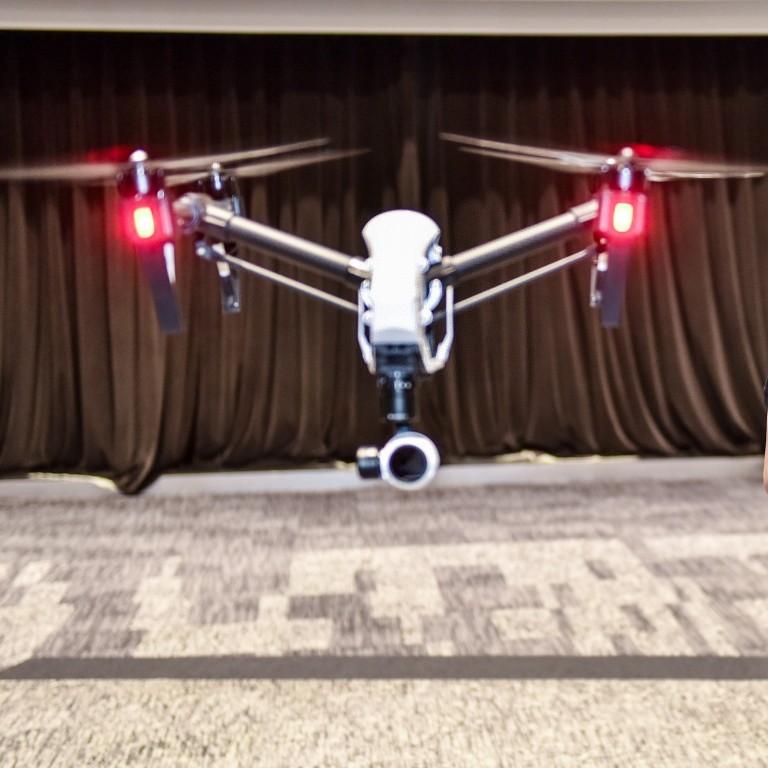
Chinese drone maker DJI monitors US blacklist as it develops own tech
- A US warning on the security risks of Chinese-made drones has raised the spectre of DJI being placed under a trade ban
From a cramped room at a university dormitory in Hong Kong, SZ DJI Technology has grown to become the world largest drone maker, whose products are sold in more than 100 countries.
In recent years, however, DJI has joined a growing number of major Chinese technology companies portrayed by the US government as security threats with potential ties to Beijing’s intelligence sector. The US Army banned the use of drones from DJI in 2017 because of security concerns.
Earlier this week, the US Department of Homeland Security advised American companies about the inherent security risks associated with Chinese-made drones. Although the alert did not name a specific manufacturer, nearly 80 per cent of the drones used in the US and Canada are estimated to come from Shenzhen-based DJI.
In a related development, the US government was also reportedly considering placing Chinese surveillance systems providers, including Hikvision Digital Technology and Dahua Technology, on a trade blacklist that would cut off their access to American hi-tech suppliers.
“We do not have magic,” a DJI spokesman said on Thursday. “Like everyone else, we are carefully monitoring the ongoing negotiations between China and the US.”
US warns companies of security threats posed by Chinese-made drones
He said DJI’s business “has not been materially impacted” by the two countries’ trade dispute.
Still, the spokesman said it was difficult for DJI to speculate about what might happen next, adding that all it can do would be “to serve our customers well in the US and China, and bring them the best drone technologies”.
The Department of Homeland Security warning adds to the chorus of voices against the hi-tech ambitions of China and its biggest champions. This has led Chinese companies to examine whether they can survive without relying on US technology, a process that is expected to speed up an unwinding of the highly integrated global supply chain. For decades, the conventional thinking was that lower-cost countries, such as China, would take up the bulk of manufacturing operations for richer economies like the US, whose consumers would enjoy cheaply produced goods from those places.
The US government last week placed Huawei Technologies, the world’s largest telecommunications equipment supplier, and its affiliates on a trade blacklist that restricts the group from buying hardware, software and services from American hi-tech firms without Washington’s approval. That followed US President Donald Trump’s signing of an executive order that bans US companies from using telecoms gear made by firms that pose as a national security risk.
China’s DJI turns its eye to enterprise uses like agriculture after conquering global commercial drone market
DJI, in response to the US alert, said its technology has been independently verified by the US government and leading US businesses. Its drones have a wide range of applications across the US, from local law enforcement and medical deliveries to infrastructure operations and aerial photography.
Plenty of the drones sold by DJI are used to take aerial videos and photos. These applications depend on sophisticated image-transmission chips, which are mostly imported from the US, according to people familiar with the matter. Chinese chip providers cannot guarantee good image resolution using their products, so DJI has started to develop its own chips to be less reliant on external providers, the people said.
On its Phantom 4 drones, for example, DJI uses vision processing chips from Movidius, a company owned by US semiconductor giant Intel Corp, according to a report by Jefferies. It said the Movidius chips enable the Phantom 4 to sense and avoid obstacles in real time.
“DJI, as a global technology company … seeks the best components available in the global supply chain,” the DJI spokesman said. “In some cases, we develop our own technologies.”
A privately held company, DJI does not disclose its supply chain operations.
How DJI went from university dorm project to world’s biggest drone company
Shao Jianhuo, a vice-president of DJI, told China Daily two years ago that the fast-growing consumer drone industry should not copy the model of the personal computer and smartphone industries, in which one chip company controls nearly the whole market.
DJI has more than 14,000 employees, with 25 per cent of that headcount focused on research and development. It has 17 offices globally, four of which are located in US, according to the company.
In Palo Alto, California, DJI has teams involved in marketing as well as research and development. In Los Angeles and New York, DJI’s offices are focused on marketing and customer service. DJI’s office in Washington oversees policy research and government relations.
DJI’s new headquarters in Shenzhen, which is set to open in 2022, will put all its staff, literally, under one roof.
“DJI is a fully integrated company, meaning we own all our factories,” the company spokesman said. “DJI can achieve fast turnaround because it does everything in-house.”


